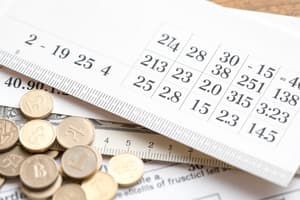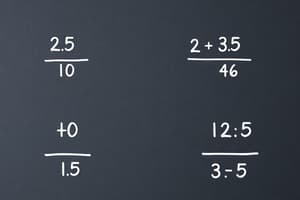Podcast
Questions and Answers
How do you add two or more decimals without regrouping?
How do you add two or more decimals without regrouping?
Align the numbers based on their place values, make sure they have the same number of decimal places, and perform regular addition starting from the leftmost digit.
Why is it important to align decimals based on their place values when adding without regrouping?
Why is it important to align decimals based on their place values when adding without regrouping?
Aligning decimals based on place values ensures that the digits are added correctly, maintaining the positional significance of each digit.
When is it necessary to pad decimals with zeros when adding them?
When is it necessary to pad decimals with zeros when adding them?
Decimals need to be padded with zeros when they do not have the same number of decimal places to maintain uniformity during addition.
What is the purpose of estimating the sum of decimals?
What is the purpose of estimating the sum of decimals?
Describe a common estimation strategy for finding the sum of decimals.
Describe a common estimation strategy for finding the sum of decimals.
Explain the process of adding decimals without regrouping.
Explain the process of adding decimals without regrouping.
How can estimating the sum of decimals be helpful in mental math?
How can estimating the sum of decimals be helpful in mental math?
Describe the process of adding decimals with regrouping using visual aids.
Describe the process of adding decimals with regrouping using visual aids.
Why is understanding how to add and estimate decimals crucial in mathematical operations?
Why is understanding how to add and estimate decimals crucial in mathematical operations?
Explain why comparing the order of magnitude of numbers is useful in estimating the sum of decimals.
Explain why comparing the order of magnitude of numbers is useful in estimating the sum of decimals.
How can dividing decimals by powers of ten help in obtaining a more accurate estimate?
How can dividing decimals by powers of ten help in obtaining a more accurate estimate?
Flashcards are hidden until you start studying
Study Notes
Adding and estimating decimals are fundamental concepts in arithmetic that help us understand decimal equations and make approximate calculations. In this article, we will explore these concepts, starting with adding decimals without regrouping, followed by methods for estimating the sum of decimals, and finally, how to add decimals with regrouping.
Adding Decimals Without Regrouping
To add two or more decimals without regrouping, follow these steps:
- Align the numbers based on their place values.
- Check if all the decimals have the same number of digits after the decimal point. If not, pad any decimals with fewer decimal places with zeros on the right.
- Starting from the leftmost digit, perform regular addition with carryover if necessary. Add the first digit first and move onto the next column only when you've finished adding the current one.
For example, let's add 3.298 and 7.5. Since both numbers have two digits after the decimal point, they can be added directly:
+ 7.5
----+--
3 | 2
.98| .
-7.5
---+---
6 | 2
.98| .
The result is 11.27, which represents 11.270. This process simplifies the addition of decimals by maintaining the original value's precision and avoiding the need for regrouping.
Estimating Sum of Decimals
Estimation techniques can be used to obtain approximations of the actual sum of decimals, especially when dealing with large numbers or performing complex calculations. Here are some common estimation strategies:
- Round each decimal to the nearest whole number. For example, rounding
3.14to the nearest whole number gives us3. Then, add the rounded numbers together. - Divide each decimal by a power of ten, truncate the decimal part, and multiply it back by the power of ten. This method provides a more accurate estimate compared to previous methods, but it requires knowledge of powers of ten.
- Analyze and compare the order of magnitude of the numbers. A rough estimate can be obtained by comparing the size of numbers and determining whether one number is significantly larger than the other.
These methods enable us to quickly determine the approximate sum of decimals without performing full calculations, making them useful for mental math or quick approximations.
Adding Decimals With Regrouping
When adding decimals with regrouping, visualize the numbers as bars representing their corresponding units, tens, hundreds, etc., and align them accordingly. Some key points to remember during this process include:
- When a decimal has digits beyond the decimal point, draw lines parallel to the decimal line to represent the digits.
- Treat each group of digits as if it were whole numbers and add them using normal addition rules.
- After adding a group, move on to the next group and repeat the process until all groups have been considered.
For example, consider adding 3.4 and 7.2. Drawing the numbers as follows:
_______
| |
| 3.|
|_____|
.4
________
| |
| 7. |
|________|
.2
Now, treat each group as if it were whole numbers:
3 + 7
+-----+------
10 10
Finally, add the remaining digits:
3 + 2
------------
5
So, 3.4 + 7.2 = 10.6. This method allows us to handle decimals with varying length and complexity.
In summary, understanding how to add and estimate decimals is crucial for working with decimal quantities. By following the appropriate procedures and utilizing various estimation techniques, we can efficiently manipulate decimal numbers and derive the desired outcomes in our mathematical journey.
Studying That Suits You
Use AI to generate personalized quizzes and flashcards to suit your learning preferences.




